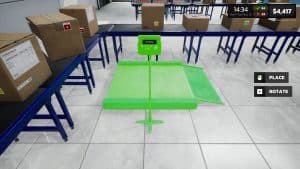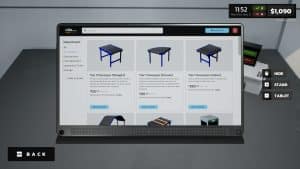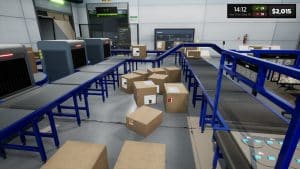Parcel Simulator
Related Games
Description
🔥 What is Parcel Simulator
Parcel Simulator is a first-person package inspection and automation management game developed and published by Dansan Digital, offering players the experience of transforming a small, cluttered workspace into a fully optimized delivery hub. The game captures the gradual shift from slow, hands-on parcel checks to the satisfying hum of a self-sustaining sorting network. Every box tells a story, from its carefully printed label to the unseen journey it will take once it leaves the warehouse.
Set within a bustling industrial environment, the experience unfolds as a mix of meticulous inspection, thoughtful layout design, and progressive automation. As new tools and conveyor systems are introduced, the warehouse becomes less a place of constant labor and more a testament to careful planning and efficient execution.
👉 Features of Parcel Simulator
Detailed Parcel Inspection
Every shipment arrives with unique traits labels, barcodes, and weight readings that hint at its contents and destination. The early game focuses on these quiet, deliberate checks, where the smallest detail can decide the parcel’s path. Careful observation forms the foundation of efficiency, ensuring that no package is misplaced or overlooked.
Gradual Automation Development
As the business grows, conveyors begin to weave through the warehouse like arteries, feeding parcels to scanners, sorters, and dispatch bays. The transition from manual handling to mechanical precision creates a tangible sense of progress. This evolving infrastructure turns once-chaotic days into a smooth and controlled operation.
Strategic Warehouse Expansion
Small rooms soon give way to larger facilities, each capable of handling greater parcel volumes. Upgraded stations, faster belts, and more dispatch zones allow for broader logistical control. Expansion feels earned, reflecting both strategic investment and accumulated expertise.
Workflow Optimization and Efficiency Gains
The heart of Parcel Simulator lies in refining the system. The placement of a single scanner or conveyor junction can reshape the entire flow, saving precious seconds and streamlining operations. These small adjustments compound over time, creating a warehouse that feels uniquely tailored to its operator.
Gameplay
From Hands-On Work to Automated Flow
The early days are defined by direct interaction with parcels lifting them, scanning their codes, and deciding their route. Gradually, these tasks give way to a mechanical symphony where conveyors and sorters move goods with clockwork precision. The satisfaction lies in watching a system you designed operate flawlessly without intervention.
Expansion as a Marker of Success
Each new section of the warehouse is more than just extra space it’s a visible milestone in the company’s growth. Larger intake bays allow higher throughput, while improved inspection points reduce errors and keep the workflow steady. Growth is measured not only in scale but also in the quality of the process.
Balancing Speed and Accuracy
Even with automation, the warehouse thrives on balance. Faster sorting means little without accuracy, and the most careful checks mean nothing if the system stalls. Maintaining this equilibrium becomes a constant, rewarding challenge.
The Living Warehouse
As machines hum and belts carry endless streams of parcels, the warehouse itself begins to feel alive. Each addition, from new scanners to faster belts, adds to its character and capability. The end result is more than just an efficient space it is a reflection of its builder’s vision.
Graphics
Realistic Industrial Setting
The warehouse is presented with a grounded, functional design that captures the look and feel of a working logistics hub. Stacks of parcels, metal shelving, and machinery form a convincing backdrop for the action. Lighting and textures enhance the sense of scale, making even small spaces feel full of purpose.
Clear Visual Communication
Every element serves both an aesthetic and functional role. Conveyor belts convey motion, scanners flash with activity, and dispatch bays glow when ready for shipments. This clarity ensures that the visual design supports, rather than distracts from, the gameplay.
Evolving Visual Identity
With each upgrade, the warehouse changes in appearance. New machinery, expanded floors, and cleaner layouts tell the story of growth without a single word being spoken. Watching the space transform over time is as satisfying as the gameplay itself.
Subtle Environmental Details
Small touches like worn labels on old boxes or the metallic sheen of freshly installed conveyors add depth and authenticity. These details remind players that their warehouse is a place with history, not just a backdrop for tasks.
Pros and Cons
✔️ Pros
- Gradual and rewarding transition from manual work to automation.
- Strategic layout design creates a strong sense of ownership.
- Visual changes reflect tangible progress in operations.
- Atmospheric industrial setting enhances immersion.
❌ Cons
- Fully automated systems may reduce the sense of challenge over time.
- Large-scale layout changes can become tedious to plan.
- Late-game flow may feel repetitive for players seeking constant novelty.
ℹ️ Game information
Release Date: 20/06/2025
Update Date: 18/08/2025
Version: v1.0
Genre: Simulation
Platform: PC
Language: ![]()
![]()
![]()
![]()
![]()
![]()
![]()
![]()
Weight: 4 GB
Additional info: New version includes all DLCs to date
⭐ Installation Instructions
- The game is fully complete, you just need to install it, so there is no need to unpack it or download it from other sources.
- Just run the Parcel Simulator.exe installation file.
- Simply launch the game from shortcut desktop.
⚙️ System Requirements
✅ Minimum:
- OS: Windows 10 64-bit
- Processor: Intel Core i5 10400 / AMD Ryzen 3 1200
- Memory: 8 GB RAM
- Graphics: Nvidia GeForce GTX 970 / AMD Radeon RX 580
- DirectX: Version 11
- Network: Broadband Internet connection
- Storage: 4 GB available space
✅ Recommended:
- OS: Windows 10 64-bit
- Processor: Intel Core i5 10400 / AMD Ryzen 5 3600
- Memory: 16 GB RAM
- Graphics: Nvidia GeForce GTX 1650 4GB / AMD Radeon RX 570 4GB
- DirectX: Version 11
- Network: Broadband Internet connection
- Storage: 4 GB available space
Images






